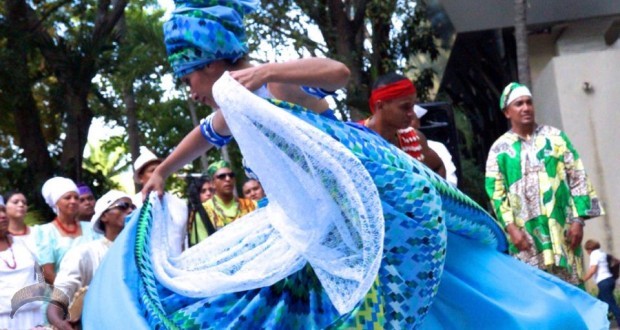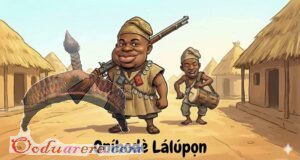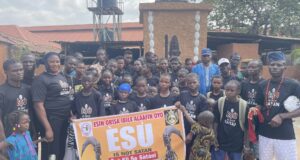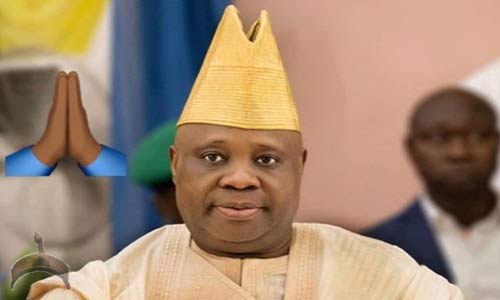Question: Is the Oba like a king?
Fa’lokun: He is a king. There are only twenty one Oba in Yorubaland. They rule regions about the size of a state. Technically an Oba would be like a prince using European language and the Oni of Ile Ife would be the king. Actually there is a dual monarchy, so the Oni of Ile lfe and the Alaafin of Oyo would be the kings of the Yoruba Nation. The Oni of Ile Ife would be the chief spiritual elder and the Alaafin would be the national chief of Ogboni.
The women still put the crown on the Oba’s head and he cannot sit as Oba unless he is wearing his crown. If he messed up real bad, either the male or female council of elders could tell the Oba to commit suicide. Looking at this arrangement historically, we have a balance of power, followed by a period of excessive female power, followed by a period of excessive male power. But throughout this we have the effort of Ifa and both councils of elders to find some formula for creating and sustaining the idea of balance. This suggests that Ifa as a personal religion of transformation and as a model of social organization is a system in process.
The point here is that we are trying to create permanent, eternal political and social structures in the midst of evolving historical circumstances. So we have these flip flops. The last flip flop lasted a long, long time until a very specific external influence pulled the pin out of the whole system. Do you know what that was?
Answer: Colonialism.
Fa’lokun: Colonialism and Christian missionaries both looked at the world view of Ifa and said, “You can do everything you want except ask the Oba to commit suicide. We’re making that against the law.” Then they went to the Oba and said, “You can be the chief trader if you convert to Christianity.” This is really insidious because it was so calculated. The first Oba to convert to Christianity was in 1532. Then we have the consequence of this, which was obviously and tragically slavery. After some time, we have two significant religious reactions to slavery. In the west we had Quakers who were historically the first Western religion to actively protest against the idea of slavery.
What was the reaction against slavery in Ifa, does anybody know? It is called Gelede. Gelede is the most recent addition to Ifa ritual practice. It developed in the 18th century. I believe that it developed as a reaction to slavery. The mothers were not happy. The mothers said, “This is not happening, we want an end to slavery.” What does Gelede mean? It means; “Sitting on the earth, standing up.” So whatever it was that was sitting on the earth to bring coolness, stood up and said “wrong – not.”
Gelede is also a synonym for giving birth. We have the idea that the female elders in the community defined the parameters of acceptable behavior within the culture. It is Oshun with the allure of the erotic, Yemoja with the nurturing of life and Oya as the inspiration for Justice that create the vision of family. The purpose of the extended family is to support the vision that comes with the lure of the erotic and to nurture the children of the family. In Ifa, we believe that reincarnation occurs through the family, so if your lineage dies, the family both in Heaven and on Earth comes to an end. If your family lineage ends with you, you can’t come back to earth through the process of reincarnation. Coming back is considered a good thing. So the mothers as the holders of reproductive power, define socially acceptable behavior within the extended family in such a way that it supports their divine mandate to conceive, nurture, support and transform children. This is very clear just from the literal meaning of the Yoruba words used to describe and define the family.
Lets look at the idea of extended family within the political structure. We’ve discussed the Creation of the Universe, the Creation of the Earth, the Creation of the political structure and Creation of the family. This leads us to the current historical issues for 1994 living in Oakland. So I’m going to tell you a secret. All of us who have been initiated have what is called an Ita. This is divination that tells us what we are supposed to do as elders in the community. My Ita says that Oshun and Ifa must be treated equally. If you go to an Ifa shrine in Africa, you will see Ifa on the right side and Oshun or whatever female Orisa there on the left side. Now, if anybody has ever been in my shrine, they will see Ifa on the left side and Oshun on the right. This is a symbol of the never-ending relationship between expansion and contraction, opposites emerging from each other, the balance of yin and yang. Placing the female spirit on the male side and the male spirit on the female side is a symbolic representation of this balance.
 Ọmọ Oòduà Naija Gist | News From Nigeria | Entertainment gist Nigeria|Networking|News.. Visit for Nigeria breaking news , Nigerian Movies , Naija music , Jobs In Nigeria , Naija News , Nollywood, Gist and more
Ọmọ Oòduà Naija Gist | News From Nigeria | Entertainment gist Nigeria|Networking|News.. Visit for Nigeria breaking news , Nigerian Movies , Naija music , Jobs In Nigeria , Naija News , Nollywood, Gist and more









